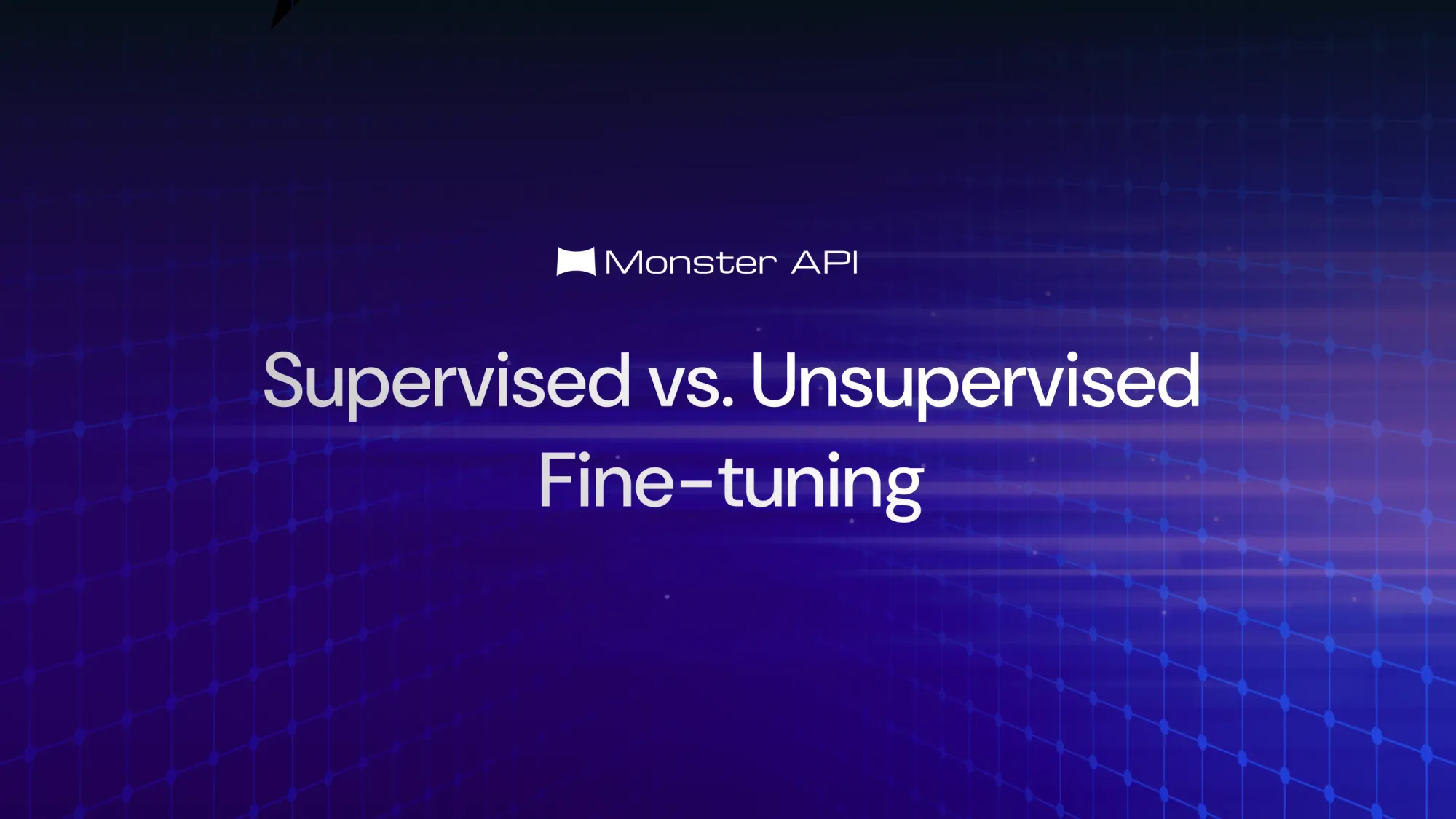Supervised vs Unsupervised LLM Finetuning: A Comprehensive Guide
Choosing between supervised LLM finetuning and unsupervised LLM finetuning can be a challenge. In this guide, we're helping you make an informed decision.

Large language models have become a part of almost every industry today. Why? Because of their understanding and capabilities to generate human-like text. But out-of-the-box LLMs have limitations, they will give you a response, but their accuracy and quality will be poor at times.
Now assume you have a very niche use case where you want the model to do one thing but it should do ‘that one thing’ perfectly. That’s where LLM fine-tuning comes into play.
There are two techniques to fine-tuning a large language model - supervised and unsupervised learning.
In this blog post, we’ll review the definitions, advantages, and disadvantages and guidance on choosing the right method for your needs.
What is Supervised Learning?
Supervised learning in LLM fine-tuning is a process where the model is trained on a dataset of input-output pairs. In this context, the input is typically a prompt or question, and the output is the desired response.
The model learns to map inputs to outputs by adjusting its parameters to minimize the difference between its predictions and the target responses provided.
Advantages of Supervised Learning
- Precise Control: You have direct control over what the model learns, as you provide specific examples of desired behavior.
- Task-Specific Performance: It excels at improving performance on well-defined tasks with clear right and wrong answers.
- Faster Convergence: Generally requires fewer training examples to achieve good performance on the target task.
- Easier Evaluation: Performance can be measured directly against the provided correct answers.
Disadvantages of Supervised Learning
- Data Requirements: High-quality labeled datasets are often expensive and time-consuming to create.
- Potential for Overfitting: The model may memorize specific examples rather than learning generalizable patterns, especially when working with small or narrowly focused datasets.
- Limited Scope: The model's improvements are typically limited to the specific tasks covered in the training data.
- Bias Introduction: Supervised learning may unintentionally reinforce the biases present in the labeled data, and these biases can be harder to detect in larger datasets.
What is Unsupervised Learning?
Unsupervised learning in LLM fine-tuning involves training the model on a large corpus of unlabeled text data.
The model learns by predicting the next token in a sequence (or filling in missing words in a context), improving its general language understanding without being guided towards specific task-oriented outputs.
Advantages of Unsupervised Learning
- Scalability: Can leverage vast amounts of easily obtainable unlabeled text data.
- Broader Knowledge: Improves the model's general language understanding across a wide range of topics.
- Flexibility: The resulting model can be applied to various tasks without task-specific training.
- Potential for Novel Insights: May discover patterns and relationships not explicitly defined by humans.
Disadvantages of Unsupervised Learning
- Less Control: It's harder to guide the model towards specific desired behaviors or outputs.
- Computational Intensity: Often requires significant computational resources due to the large amount of data processed.
- Difficulty in Evaluation: Assessing the quality of unsupervised learning outcomes can be challenging and less straightforward.
- Potential for Reinforcing Biases: May amplify biases present in the training data without careful curation.
Final Comparison
When deciding between supervised and unsupervised fine-tuning for LLMs, consider the following factors:
- Data Availability: If you have high-quality labeled data for your specific task, supervised learning may be more appropriate. If you have access to large amounts of unlabeled text data relevant to your domain, unsupervised learning could be beneficial.
- Task Specificity: For narrow, well-defined tasks with clear correct answers, supervised learning often yields better results. For improving general language understanding or tackling a variety of related tasks, unsupervised learning may be more suitable.
- Resources: Supervised learning typically requires less computational power but more human effort in data labeling. Unsupervised learning often needs more computational resources but less human intervention.
- Control vs. Flexibility: Supervised learning offers more control over the model's outputs, while unsupervised learning provides more flexibility in applying the model to various tasks.
- Ethical Considerations: Both methods can potentially amplify biases, but supervised learning allows for more direct control over the model’s behavior, which can be crucial for sensitive applications.
In practice, many state-of-the-art LLM fine-tuning approaches use a combination of both supervised and unsupervised techniques, leveraging the strengths of each method to create more robust and versatile models.
FAQs
Q: Which method is better for domain-specific applications?A: Supervised learning is often better for domain-specific applications, as it allows you to train the model on examples directly related to your use case.
Q: Can I use both methods together?A: Yes, combining supervised and unsupervised learning—commonly referred to as semi-supervised learning—leverages the strengths of each approach to create more versatile models.
Q: How much data do I need for each method?A: Supervised learning can yield good results with a few thousand high-quality examples. Unsupervised learning typically requires much larger datasets, often millions of tokens or more.
Q: Which method is more cost-effective?A: Supervised learning may be more cost-effective if you already have labeled data and a specific task in mind. Unsupervised learning, though requiring more compute power, can be cheaper if you have access to large amounts of unlabeled text.
Q: How do I choose between the two methods?A: Consider your specific use case, data availability, resources, and the level of control you need over the model’s outputs. In many cases, a combination of both methods may yield the best results.

